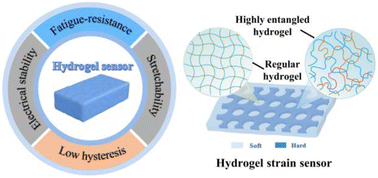Stretchable strain sensor of composite hydrogels with high fatigue resistance and low hysteresis†
Abstract
Stretchable strain sensors of conductive hydrogels have been widely used in wearable devices and soft robotics. These applications have posed combinational requirements for hydrogels: high fatigue resistance, low hysteresis, and high electrical sensitivity. This combination is hardly realized. Here we propose a composite design principle to fabricate conductive hydrogels with multiple outstanding properties in both mechanical and electrical tests. One phase of the composite hydrogel is a regular polyacrylamide (PAAm) hydrogel, and the other phase is a highly entangled conductive PAAm hydrogel. The topological polymer network of each hydrogel phase is tuned by changing the density of the crosslink and entanglement to achieve different mechanical properties. The composite hydrogel shows a high fatigue threshold (∼330 J m−2), low hysteresis (<3%), high resolution (1%), and wide range (0–200%) of strain sensing capabilities. In particular, hysteresis is one order of magnitude lower than that of reported conductive hydrogels and elastomers. These merits qualify the strain sensor for monitoring cyclic motion signals, such as bending of joints (fingers, wrists, elbows, and knees), moving of a robotic arm, and beating of a porcine heart in vitro. The resistance of the sensor changes accordingly with the beating of the heart for 500 cycles. This strain sensor of composite hydrogels with high fatigue resistance and low hysteresis may open new opportunities in stretchable electronics and soft robotics.

- This article is part of the themed collection: Journal of Materials Chemistry A HOT Papers


 Please wait while we load your content...
Please wait while we load your content...